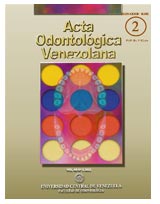MICROFILTRACIÓN EN MÁRGENES DE ESMALTE Y DENTINA RESTAURADOS CON IONÓMERO DE VIDRIO CONVENCIONAL: EL EFECTO DEL TRATAMIENTO DADO AL SUSTRATO DENTARIO
Palabras clave:
adhesión, ionómero de vidrio convencional, restauración clase V, micro-filtración marginal,Resumen
Objetivo: Evaluar "in vitro" el efecto que distintas sustancias acondicionadoras tienen sobre los niveles de microfiltración mostrados por un ionómero de vidrio convencional adherido a márgenes de esmalte y dentina. Materiales y métodos: 50 terceros molares fueron preparados con dos cavidades clase V y posteriormente distribuidos dentro de uno de los siguientes grupos: A) sin tratamiento previo de la superficie cavitaria, B) tratamiento con NaOCl, C) tratamiento con ácido poliacrílico al 10%, D) tratamiento con NaOCl + ácido poliacrílico al 10% y E) ácido fosfórico al 37%. Seguidamente, las muestras fueron restauradas con un ionómero de vidrio tipo II convencional y finalmente se sometieron a 1.000 ciclos térmicos de frío (5°C) y calor (55°C) para ser evaluadas por medio de un test de microfiltración con fucsina básica. Resultados: El análisis estadístico mediante el test Krust-Wallis mostró diferencias significativas entre los 5 grupos de experimentación en esmalte y dentina. En márgenes de dentina el análisis del test Mann-Whitney U, comprobó diferencias significativas en los niveles de microfiltración mostrados por el grupo E en comparación con los grupo restantes (E ≠ A,B,C,D). En márgenes de esmalte se encontraron diferencias significativas entre los grupo B y C (B ≠ C), y entre el grupo E comparado con los grupos A, B y D (E ≠ A,B,D). Conclusión: El pre-tratamiento de la superficie cavitaria con ácido fosfórico al 37%, puede afectar la calidad de la adhesión obtenida entre un ionómero de vidrio convencional y la estructura dentaria, tanto en márgenes de esmalte con en dentina.MICROLEAKAGE IN MARGINS OF ENAMEL AND DENTIN RESTORED WITH CONVENTIONAL GLASS IONOMER: THE EFFECT OF TREATMENT GIVEN TO DENTAL SUBSTRATE
Abstract
Objective: To evaluate "in vitro" the effects of different conditioners on the microleakage levels shown by a conventional type II glass ionomer applied in dentin and enamel margins. Materials and methods: 50 third molars extracted were subject to two class V cavities and assigned to one of the following treatments: A) no previous treatment of cavitary surface, B) NaOCl, C) 10% solution of polyacrylic acid, D) NaOCi + a 10% solution of polyacrylic acid and E) a 37% solution of phosphoric acid. The samples were restored with a conventional type II glass ionomer and finally were thermocycled to 1000 cycles between 5ºC and 55ºC and evaluated with a microleackage test with basic fucsine. Results: A statistic analysis using the Krust-Wallis test showed significant differences among the 5 experimental groups, in enamel as well as in dentin. In dentin margins the Mann-Whitney U test analysis showed significant differences in the levels of microleakage shown in group E, compared to the other groups (E ≠ A,B,C,D,). In enamel margins, significant differences were found between groups B and C (B≠C) and in group E compared to groups A, B and D (E ≠ A, B, D). Conclusions: Pre-treatment of cavity surface with a 37% solution of phosphoric acid may affect the quality of the obtained bounding between the conventional glass ionomer and dental structure in enamel margins as well as in dentin margins.
Descargas
Los datos de descargas todavía no están disponibles.


